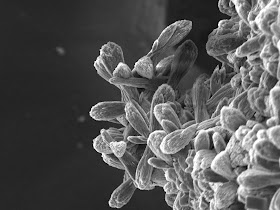I am an astrobiologist, sci-fi geek, and professor of everything groovy. I write about science, culture, math, history, space, and science fiction. Perhaps like you, I'm seeking a greater understanding of the nature of life and asking myself why all of this really matters. Come with me, and we'll ask some questions together.
Friday, August 23, 2013
Hot Wheels Rovers
Carbonate Dumbbells from Gradient-Tube Cultures
I started some gradient-tube cultures late last year. They were inoculated with organisms that had been isolated from our Borup samples. The gradient-tubes are set up so that an agar plug in the bottom of the tube contains some amount of sulfide and the tube is open to the air. This produces a gradient of high-sulfide/low-oxygen near the bottom of the tube to low-sulfide/high-oxygen near the top of the tube. Using such cultures, we can provide environments within the culture tubes where sulfur-metabolizing organisms can find their optimum growth regime within the chemical gradient.
I've allowed these tubes to sit for quite sometime (over 7 months) before coming back to check on them. I've seen a slew of interesting things happening inside the tubes, some of which might be a good branching point for further experimentation. One interesting finding was that tubes with a certain kind of media contain mineral grains which have a unique "dumbbell" morphology. Here is the first image I took of one of these minerals:
I've allowed these tubes to sit for quite sometime (over 7 months) before coming back to check on them. I've seen a slew of interesting things happening inside the tubes, some of which might be a good branching point for further experimentation. One interesting finding was that tubes with a certain kind of media contain mineral grains which have a unique "dumbbell" morphology. Here is the first image I took of one of these minerals:
After hunting through some of my other cultures, I found one tube that contained an abundance of these minerals:
I wasn't too sure what to make of these structures at first. I managed to get a sampling of these minerals onto a surface of carbon-tape on an aluminum-plug to use for electron microscopy. Earlier this week, using a scanning electron microscope (SEM) in high-vaccuum mode with an x-ray energy-dispersive spectroscope (EDS) I managed to get a decent image and spectrum for these minerals. Here is a low-quality image at lower-magnification from SEM:
The EDS data corroborated one hypothesis as to the chemical nature of these structures. They appear to be carbonate minerals. A quick search for dumbbell minerals will show that carbonates have been discovered in a dumbbell morphology like this previously, although I haven't yet found any others that are formed exactly the way mine are. One big question that remains here is whether microorganisms within the culture tubes are in some way responsible or at least involved in the process of formation of these structures, or if the chemistry of the culture medium alone dictates whether these things will form. This wasn't something I had expected to find, nor is it something I expect to become a major part of my graduate work, but these dumbbell minerals from my gradient-tube cultures are pretty interesting.



